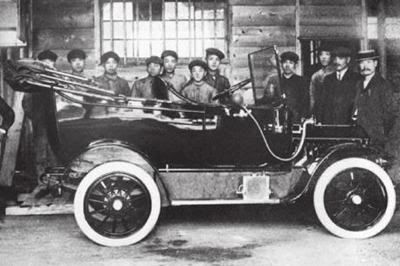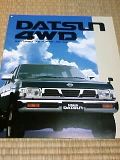The Datsun brand of cars came out of the merger of two early Japan car companies, DAT Automobile Co. and Jitsuyo Automobile Co. This new company DAT Automobile Manufacturing Co., Ltd. eventually created the Datsun brand. Shortly after the first Datsun was produced in 1931, the fledgling Nippon Sangyo holding company, desiring to enter the automobile business, sets its eyes on the Datsun car. So in 1933 it takes over DAT. The next year Nippon Sangyo names the car company Nissan Motors. The rest is history.
Contents |
Kwaishinsha
1911: Masujiro Hashimoto forms ??????? with backers of Den, Aoyama and Takeuichi. Intials DAT are eventually applied to name the car project. In Japanese DAT (pronounced 'datto') means 'bounding away' -- a derivation of the word for rabbit/hare -- so it is fitting for ambitious automobile hopes.
1912: Hashimoto builds first prototype DAT automobile
1913: Second car, the DAT 1, is created
1914 March: DAT 1 wins a prize at Tokyo Taisho Expo
1914: ??????? (Kwaishinsha Automobile Works) is established in Tokyo. Apparently it is the first automobile manufacturer registered with the Japanese government.
1915: DAT 31 birth, with 2-liter 4-cylinder engine fitting
1916: DAT 41 birth, with bored 2.3-liter engine. Produced until 1926.
1918: Renamed to Kwaishinsha Automobile Co.
1925: Renamed to DAT Automobile Co.
Jitsuyo
1919: Kubota (the tractor company) forms a subsidiary to manufacture cars, named it ????? (Jitsuyo Automobiles) in Osaka.
Their first product is small three-wheeled cars, designed by american William R. Gorham.
1921: Jitsuyo branches into four-wheeled cars with the Lila Light Car
Merger of DAT and Jitsuyo
1926: DAT and Jitsuyo merge, to form ???????????? (DAT Automobile Manufacturing Co., Ltd.). Headquarters are in Osaka.
1930: New small car design completed, with 500cc engine fitting
Nippon Sangyo
1928: Yoshisuke Aikawa founds the holding company Nippon Sangyo (Japan/Nippon Industries). This fledging company soon begins buying or taking over other established companies.
Takeover of DAT
1931: Nippon Sangyo controls foundries and auto parts businesses, but no automobile manufacturing. Aikawa purchases controlling shares in DAT Motors
1931 August: DAT comes out with a new smaller car, the first Datson, meaning "Son of DAT".
1932: Datson mark is renamed Datsun, a more harmonious spelling. Reportedly though perhaps apocryphal, is that after the DAT factory was victimized by flooding during a typhoon, it was attributed to the "son" in Datson (son in Japanese means 'loss'). In any case, the spelling was changed to "sun". Interestingly it fits with the Japanese 'sun' flag logo shown on the 1931 Dotson catalog. Sun has no particular meaning in Japanese, except that it is pronounced 'san'. Nominally, san is a title of respect, roughly equivalent to the english Mr. or Mrs.
1932 production: 150 Datsuns.
During this time, reportedly, Lord Austin in the UK (the head of the Austin car manufacturer) heard that the Datsun was a copy of the Austin 7. The book 'Car Wars' says Austin had a Datsun obtained in Japan, shipped to England and gone over with a fine tooth comb. The result? Austin could not find anything to sue over. Some say the size, design and engine look similar to the Austin 7, however the engine is much smaller and the car design has significant differences from the Austin 7. We may conclude, that as with many cars around the world at that time, the Austin 7 probably influenced the design of the Datsun but that the Datsun was not a copy.
1933: Aikwawa merges Tobata Casting's automobile parts department with DAT Automobile. The Company is renamed ????????? (Jidosha-Seizo Co., Ltd.)
Nissan
1934: Aikawa "separated the expanded automobile parts division of Tobata Casting and incorporated it as a new subsidiary, which he named Nissan Motor (Nissan)". This is ????? (Nissan Motor Co., Ltd.), incorporated as a public company.
1934 June: The shareholders of the new company however are not enthusiastic about the prospects of the automobile in Japan, so Aikawa buys out all the Tobata Casting shareholders (using capital from Nippon Industries). At this time Nissan Motors effectively becomes owned by Nippon Sangyo and Hitachi.
1936: Datsun Type 15 birth
1937: First Nissan-branded car introduced, the Nissan Type 70
1940s: Nippon Sangyo, now popularly known as Nissan, becomes the famous Nissan "Zaibatsu" (combine) including Tobata Casting and Hitachi. It grows to include 74 firms, and to be the fourth-largest combine in Japan during the wartime years.
1947: For two years (1947 to 1948) the company was briefly called Nissan Heavy Industries Corp.
1966: Datsun Sunny birth
1970: Datsun Sunny 1200 birth
- See main article: History of Datsun 1200
End of Datsun Brand
1981-1983: After becoming one of the world's great brand names, Datsun brand name is globably replaced with Nissan badging. This was to achieve greater recognition for the Company (Nissan) rather than the better-known Brand (Datsun).
1993-1995: Datsun name used as a model name in Japan for the D21 pickup, known as Navara or Harbody in other countries.

![[Datsun 1200 encyclopedia]](/wiki/upload/wiki.png)



